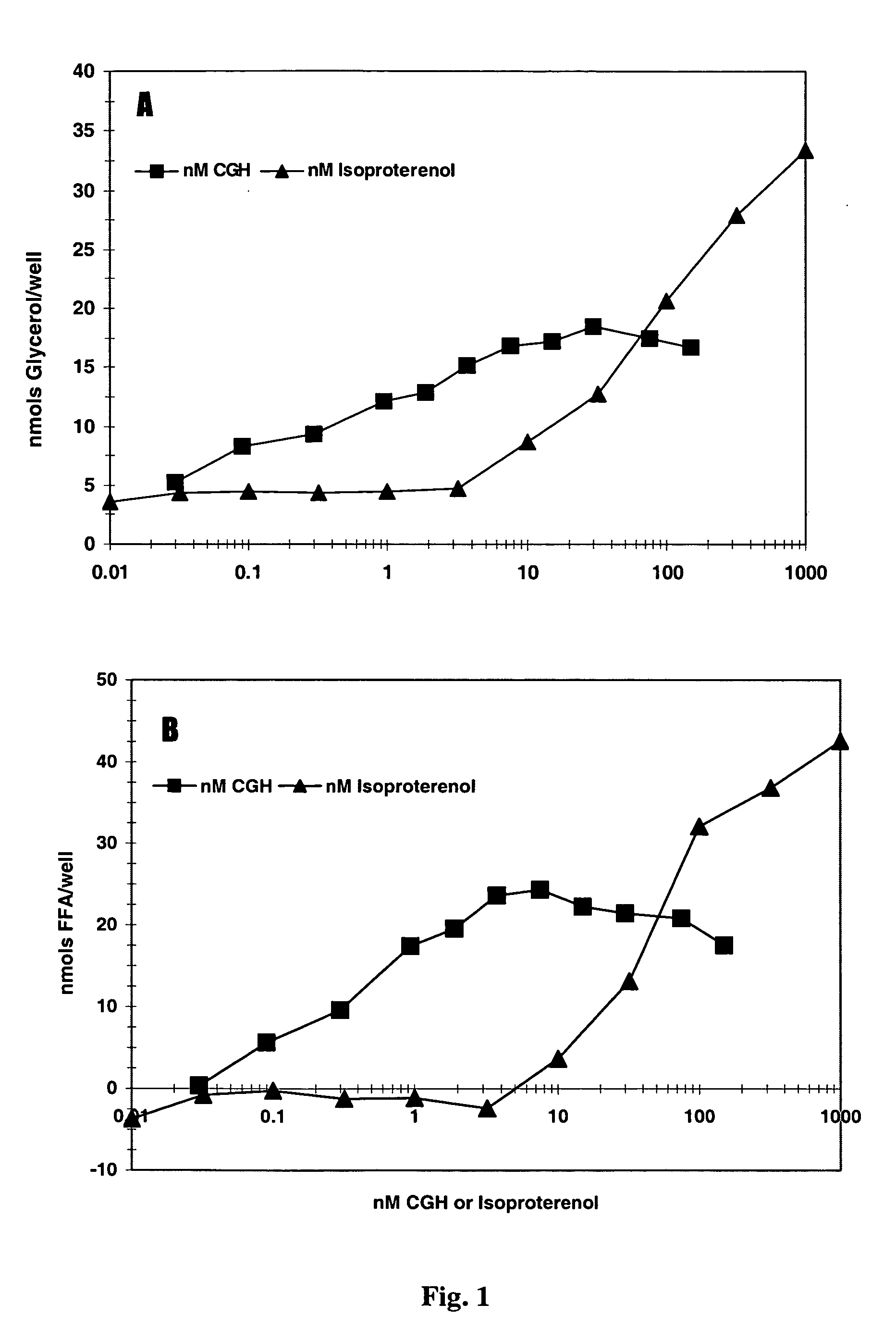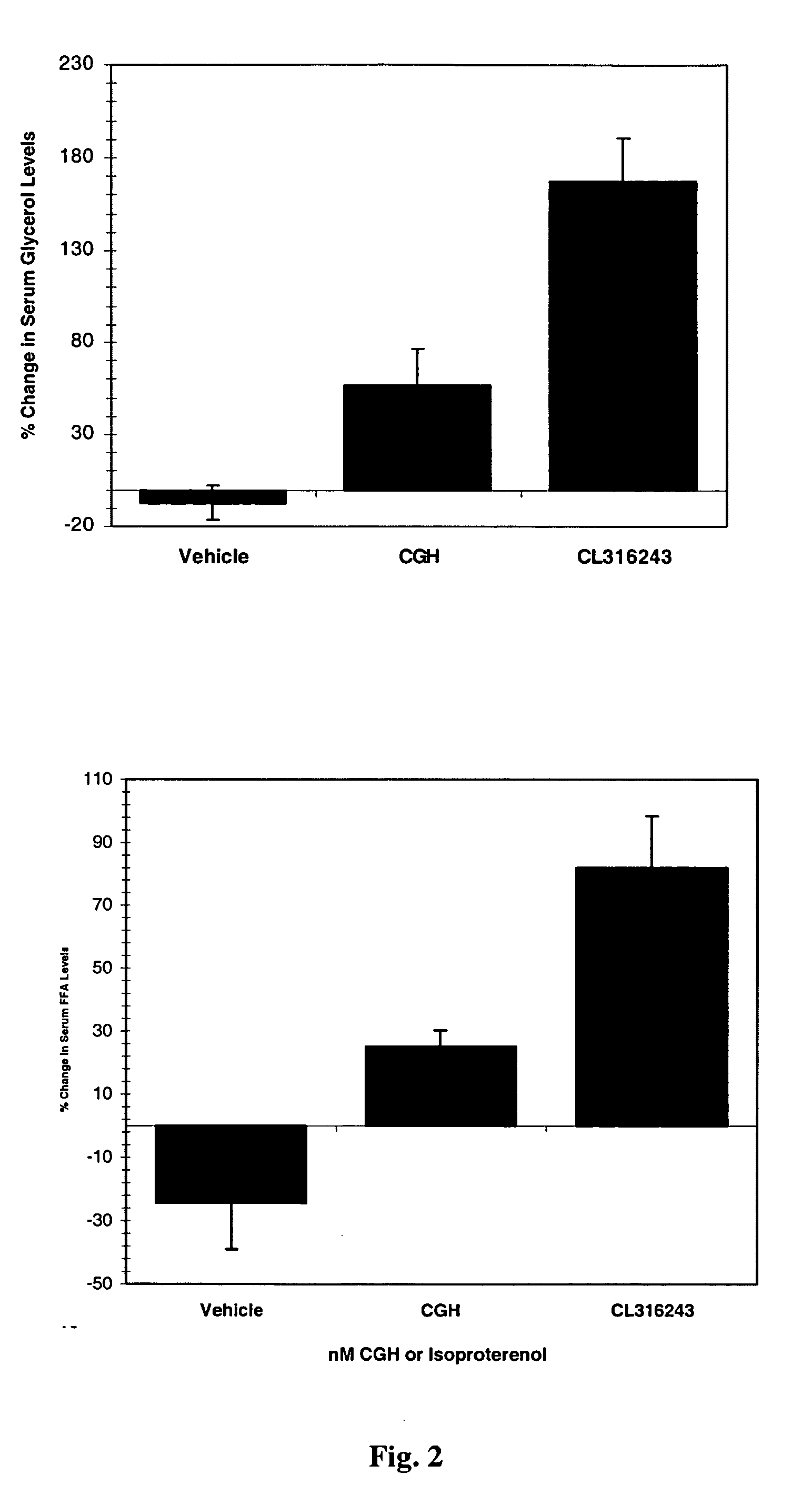Use of corticotroph-derived glycoprotein hormone to induce lipolysis
- Summary
- Abstract
- Description
- Claims
- Application Information
AI Technical Summary
Benefits of technology
Problems solved by technology
Method used
Image
Examples
example 1
CGH Activation of 3T3 L1 Adipocytes and Human Adipocytes Results in cAMP Production
Summary
[0038] Differentiated murine 3T3 L1 adipocytes and primary human adipocytes were used to study signal transduction of CGH. 3T3 L1 fibroblasts were differentiated into adipocytes and the cells were transduced with recombinant adenovirus containing a reporter construct, a firefly luciferase gene under the control of cAMP response element (CRE) enhancer sequences. This assay system detects cAMP-mediated gene induction downstream of activation of Gs-coupled G-protein coupled receptors (GPCR's). Treatment of the differentiated 3T3 L1 cells with isoproterenol, a β-adrenoreceptor agonist, resulted in elevation of cAMP levels and an 80-fold induction of luciferase expression. Treatment of differentiated 3T3 L1 cells with CGH also resulted in elevated cAMP levels and a 27-fold induction of luciferase expression. In a separate experiment, undifferentiated 3T3 L1 fibroblasts were transduced with the re...
example 2
CGH-Induced Lipolysis in 3T3 L1 Adipocytes
Summary
[0040] 3T3 L1 Adipocytes were treated with CGH and the non-specific β-adrenoreceptor agonist isoproterenol for 4 hours. Lipolysis was assessed by the accumulation of glycerol and FFAs in the conditioned medium. FIG. 1 displays dose-response curves of CGH and isoproterenol for glycerol (panel A) and FFA (panel B). CGH potently stimulated lipolysis in the murine adipocytes, as shown in FIG. 1.
Measurement of Free Fatty Acids in Conditioned Media from Differentiated 3T3 L1 Cells
[0041] Free fatty acids were measured using the Wako NEFA C kit for quantitative determination of non-esterified (or free) fatty acids with a modified protocol. Isoproterenol (ICN), a lipolysis-inducing positive control, was diluted to a starting concentration of 2 μM in assay medium (Life Technologies low glucose DMEM, 1 mM sodium pyruvate, 2 mM L-glutamine, 20 mM HEPES, and 0.5% BSA). The isoproterenol was further diluted in half log serial dilutions. CGH w...
example 3
Stimulation of Lipolysis by CGH in Vivo
Summary
[0043] CGH, the β3-adrenoreceptor agonist CL 316,243 (CL), and saline vehicle were examined for stimulation of lipolysis in mice following an overnight fast. Mice (n=4) were bled immediately before EP injection of CGH (300 μg / kg), CL (1 mg / kg), or vehicle, and then sacrificed 2 hours later. Lipolysis was assessed as the percent change in serum glycerol or FFA over the 2 hour period. FIG. 2 shows the changes in glycerol (upper panel) and FFA (lower panel) for the treatment groups. The serum glycerol and FFA for the vehicle groups decreased by 7%+ / −9% and 24%+ / −15%, respectively. The serum glycerol for the CGH group increased by 57%+ / −20%; p=0.0254, and the FFA levels increased 25%+ / −5%; p=0.0188. The serum glycerol for the CL group increased 168%+ / −23%; p=0.0004, and the FFA increased 82%+ / −16%; p=0.0029.
[0044] C57 BL / 6 male mice, age 19 weeks, were grouped to normalize weight (n=4 for each treatment; average group...
PUM
| Property | Measurement | Unit |
|---|---|---|
| Sensitivity | aaaaa | aaaaa |
| Weight loss | aaaaa | aaaaa |
Abstract
Description
Claims
Application Information
 Login to View More
Login to View More - R&D Engineer
- R&D Manager
- IP Professional
- Industry Leading Data Capabilities
- Powerful AI technology
- Patent DNA Extraction
Browse by: Latest US Patents, China's latest patents, Technical Efficacy Thesaurus, Application Domain, Technology Topic, Popular Technical Reports.
© 2024 PatSnap. All rights reserved.Legal|Privacy policy|Modern Slavery Act Transparency Statement|Sitemap|About US| Contact US: help@patsnap.com









